Weighing of souls
The weighing of souls (Ancient Greek: psychostasia)[1] is a religious motif in which a person's life is assessed by weighing their soul (or some other part of them) immediately before or after death in order to judge their fate.[2] This motif is most commonly seen in medieval Christianity.[3]

Ancient Egyptian religion
This concept of weighing something in order to judge the fate of the deceased is first seen in ancient Egypt around 2.400 B.C., where people's hearts are weighed on a scale against a feather.[2]
The Weighing of the Heart would take place in Duat (the Underworld) which the dead were judged by Anubis, using a feather, representing Ma'at, the goddess of truth and justice responsible for maintaining order in the universe. The heart was the seat of the life-spirit (ka). Hearts heavier than the feather of Ma'at were rejected and eaten by Ammit, the Devourer of Souls.
Among the Greeks
Later, during the contest of Achilles and Hector in the Iliad,[4] Zeus, weary from the battle, hung up his golden scales and in them set twin Keres, "two fateful portions of death"; this, then, is known as the kerostasia.[5][3] Plutarch reports that Aeschylus wrote a play with the title Psychostasia, in which the combatants were Achilles and Memnon.[6] This tradition was maintained among the vase painters. An early representation is found on a black-figure lekythos in the British Museum;[7] she observes "The Keres or ψυχαί are represented as miniature men; it is the lives rather than the fates that are weighed. So the notion shifts." In a psychostasia on an Athenian red-figure vase of about 460 BCE at the Louvre, the fates of Achilles and Memnon are in the balance held by Hermes.[8] Among later Greek writers the psychostasia was the prerogative of Minos, judge of the newly deceased in Hades.
Christianity
.jpg)
The first known depiction of literal weighing of souls in Christianity is from the 2nd century Testament of Abraham.[10]
Archangel Michael is the one who is most commonly shown weighing the souls of people on scales on Judgement Day.[9] This depiction began to show up in early Christianity, but is not mentioned in the Bible.[9]
Demons are often depicted trying to interfere with the balance of the scales.[11]
Other
In the literature of the Mandeans, Abathar Muzania, an angelic being, has the responsibility of weighing the souls of the deceased to determine their worthiness, using a set of scales.[12]
See also
- Scales of justice (symbol)
- Libra
References
-
- Jane Ellen Harrison, Prolegomena to the Study of Greek Religion (1922), p. 183f;
- Isaac Myer, Oldest Books in the World (New York, 1900), VIII: The Psychostasia or Judgment of the Soul of the Dead, pp 265-79. (Reprinted by Kessinger, 2005) ISBN 9781169220263.
- Brandon 1969.
- Brandon 1969, p. 99.
- Iliad, XXII.208-213.
- J.V. Morrison, "Kerostasia, the Dictates of Fate, and the Will of Zeus in the Iliad" Arethusa 30.2, Spring 1997, pp. 276-296.
- Harrison 1922, p. 183; Harrison reports that according to the Onomasticon of Pollux (iv 130), Zeus and his attendants were suspended above the action in a crane.
- BM B639, line drawing is Harrison's fig. 26, p.184
- Musée du Louvre G399, Beazley Archive.
- Hopler, Whitney. "Archangel Michael Weighing Souls". Learn Religions. Retrieved March 7, 2019.
- Brandon 1969, p. 104.
- Brandon 1969, p. 110.
- Matthew Bunson, Angels A to Z (New York:Crown), 1996.
Further reading
- Brandon, S. G. F. (1969). "The weighing of the soul". In Kitagawa; Long (eds.). Myths and symbols: Studies in honor of Mircea Eliade. Chicago University Press. pp. 91–110 – via Internet Archive.CS1 maint: ref=harv (link)